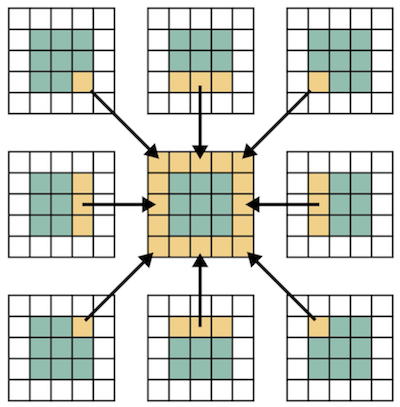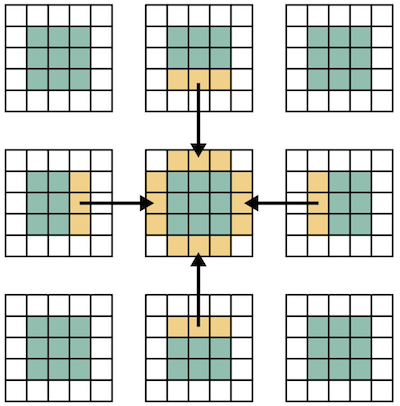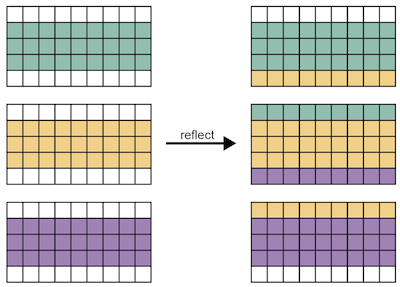13. shadow directive / reflect construct¶
The stencil computation frequently appears in scientific computations, where array elements a[i-1] and a[i+1] are referenced to update a[i]. If a[i] is on the boundary area of a distributed array on a node, a[i+1] may reside on another node.
Because it costs largely to copy a[i+1] from the neighboring node to update each a[i], a technique of copying collectively elements on the neighboring node to the area added to the distributed array on each node is usually adopted. In XMP, such additional region is called “shadow.”
13.1. Declare shadow¶
13.1.1. Widths of lower/upper bounds are the same¶
Shadow areas can be declared with the shadow directive. In the example below, an array a has shadow areas of size one on both the lower and upper bounds.
- XMP/C program
#pragma xmp nodes p[4]
#pragma xmp template t[16]
#pragma xmp distribute t[block] onto p
double a[16];
#pragma xmp align a[i] with t[i]
#pragma xmp shadow a[1]
- XMP/Fortran program
!$xmp nodes p(4)
!$xmp template t(16)
!$xmp distribute t(block) onto p
real :: a(16)
!$xmp align a(i) with t(i)
!$xmp shadow a(1)

In the figure above, colored elements are those that each node owns and white ones are shadow.
Note
Distributed arrays in a cyclic manner cannot have shadow.
13.1.2. Widths of lower/upper bounds are different¶
For some programs, it is natural that the widths of the shadow area on the lower and upper bounds are different. There is also a case where the shadow area exists only on either of the bounds. In the example below, it is declared that a distributed array a has a shadow area of width one only on the upper bound.
- XMP/C program
#pragma xmp nodes p[4]
#pragma xmp template t[16]
#pragma xmp distribute t(block) onto p
double a[16];
#pragma xmp align a[i] with t[i]
#pragma xmp shadow a[0:1]
- XMP/Fortran program
!$xmp nodes p(4)
!$xmp template t(16)
!$xmp distribute t(block) onto p
real :: a(16)
!$xmp align a(i) with t(i)
!$xmp shadow a(0:1)

The values on the left- and right-hand sides of a colon designate the widths on the lower and upper bounds, respectively.
13.2. Update shadow¶
13.2.1. General¶
To copy data to shadow areas from neighboring nodes, use the reflect directive. In the example below, an array a having shadow areas of width one on each the upper and lower bounds is reflected.
- XMP/C program
#pragma xmp reflect (a)
#pragma xmp loop on t[i]
for(int i=1;i<15;i++)
a[i] = (a[i-1] + a[i] + a[i+1])/3;
- XMP/Fortran program
!$xmp reflect (a)
!xmp loop on t(i)
do i=2, 15
a(i) = (a(i-1) + a(i) + a(i+1))/3
enddo

With this reflect directive, in XMP/C, node p[1] sends an element a[4] to the shadow area on the upper bound on node p[0] and a[7] to the shadow area on the lower bound on p[2]; p[0] sends an element a[3] to the shadow area on the lower bound on p[1], and p[2] sends a[8] to the shadow area on the upper bound on p[1].
Similarly, in XMP/Fortran, node p(2) sends an element a(5) to the shadow area on the upper bound on node p(1) and a(8) to the shadow area on the lower bound on p(3); p(1) sends an element a(4) to the shadow area on the lower bound on p(2), and p(3) sends a(9) to the shadow area on the upper bound on p(2).
13.2.2. Specify width¶
The default behavior of a reflect directive is to update the whole of the shadow area declared by a shadow directive. However, there are some cases where a specific part of the shadow area is to be updated to reduce the communication size in a point of the code.
To update only a specific part of the shadow area, add the width clause to the reflect directive.
The values on the left- and right-hand sides of a colon in the width clause designate the widths on the lower and upper bounds to be updated, respectively. In the example below, only the shadow area on the upper bound is updated.
- XMP/C program
#pragma xmp reflect (a) width(0:1)
- XMP/Fortran program
!$xmp reflect (a) width(0:1)

Note
If the widths of the shadow areas to be updated on the upper and lower bounds are equal, that is, for example, width(1:1), you can abbreviate it as width(1).
Note
It is not possible to update the shadow area on a particular node.
If no shadow area is specified on the lower bound, the reflect directive does not update it with or without a width clause. The below figure illustrates the behavior of a reflect directive for a distributed array a having a shadow area of width one only on the upper bound.

13.2.3. Update periodic shadow¶
The reflect directive does not update either the shadow area on the lower bound on the leading node or that on the upper bound on the last node. However, the values in such areas are needed for stencil computation if the computation needs a periodic boundary condition.
To update such areas, add a periodic qualifier into a width clause. Let’s look at the following example where an array a having shadow areas of width one on both the lower and upper bounds appears.
- XMP/C program
#pragma xmp reflect (a) width(/periodic/1:1)
- XMP/Fortran program
!$xmp reflect (a) width(/periodic/1:1)

The periodic qualifier has the following effects, in addition to that of a normal reflect directive: in XMP/C, node p[0] sends an element a[0] to the shadow area on the upper bound on node p[3], and p[3] sends a[15] to the shadow area on the lower bound on p[0]; in XMP/Fortran, node p(1) sends an element a(1) to the shadow area on the upper bound on node p(4), and p(4) sends a(16) to the shadow area on the lower bound on p(1).
Note
If the widths of the shadow areas to be updated on the upper and lower bounds are equal, as shown by width(/periodic/1:1) in the above example, you can abbreviate it as width(/periodic/1).
13.3. Multi-dimensional shadow¶
The shadow directive and reflect construct can be applied to distributed arrays multiple dimensions. The following programs are the examples for two-dimensional distribution.
- XMP/C program
#pragma xmp nodes p[3][3]
#pragma xmp template t[9][9]
#pragma xmp distribute t[block][block] onto p
double a[9][9];
#pragma xmp align a[i][j] with t[i][j]
#pragma xmp shadow a[1][1]
:
#pragma xmp reflect (a)
- XMP/Fortran program
!$xmp nodes p(3,3)
!$xmp template t(9,9)
!$xmp distribute t(block,block) onto p
real :: a(9,9)
!$xmp align a(j,i) with t(j,i)
!$xmp shadow a(1,1)
:
!$xmp reflect (a)

The central node receives the shadow data from the surrounding eight nodes. The shadow areas of the other nodes are also updated, which is omitted in the figure.
For some applications, data from ordinal directions are not necessary. In such a case, the data communication from/to the ordinal directions can be avoided by adding an orthogonal clause to a reflect construct.
- XMP/C program
#pragma xmp reflect (a) orthogonal
- XMP/Fortran program
!$xmp reflect (a) orthogonal

Note
The orthogonal clause is effective only for arrays more than one dimension of which is distributed.
Besides, you can also add shadow areas to only specified dimension.
- XMP/C program
#pragma xmp nodes p[3]
#pragma xmp template t[9]
#pragma xmp distribute t[block] onto p
double a[9][9];
#pragma xmp align a[i][*] with t[i]
#pragma xmp shadow a[1][0]
:
#pragma xmp reflect (a)
- XMP/Fortran program
!$xmp nodes p[3]
!$xmp template t[9]
!$xmp distribute t[block] onto p
real :: a(9,9)
!$xmp align a(*,i) with t(i)
!$xmp shadow a(0,1)
:
!$xmp reflect (a)

In the array specified in the shadow directive, 0 is set as the shadow width in dimensions which are not distributed.